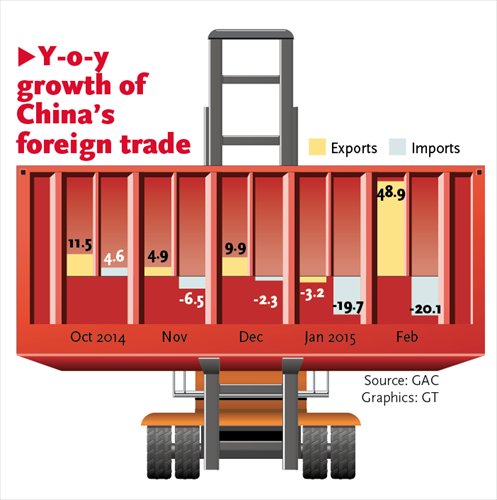

Imbalance set to continue amid weak demand
China's exports surged in February but imports saw a further decline amid weakening demand, official data showed on Sunday.
Exports surged 48.9 percent in February from a year earlier, compared with a drop of 3.2 percent in the previous month, while imports saw a 20.1 percent year-on-year fall after a 19.7 percent slide in January, China's General Administration of Customs (GAC) said in a statement on its website on Sunday.
February exports amounted to 1.04 trillion yuan ($166.3 billion) and imports reached 666.1 billion yuan, resulting in a trade surplus of 370.5 billion yuan, compared with a 137.3 billion yuan trade deficit in the same period of 2014, according to the GAC.
The Spring Festival holidays had a big impact on foreign trade in the first two months of this year because Chinese enterprises usually have massive exports before the holidays, the GAC said.
This year's Spring Festival holidays ran from February 18 to 24, while the holidays in 2014 were from January 31 to February 6.
The extraordinary growth in exports could be due to the base effect, Liu Ligang, chief China economist at ANZ Banking Group, wrote in a note on Sunday. He said the figure for February 2014 was extremely low, partly because of a crackdown in China on false trade flows.
"However, even considering the holiday influence and base effect, the large gap between exports and imports is beyond expectations," Bai Ming, a research fellow at the Chinese Academy of International Trade and Economic Cooperation, told the Global Times Sunday.
China has launched a series of new foreign trade policies since 2014, including raising export tax rebates. China has also benefited from the economic recovery in developed economies, Bai noted.
In the first two months of 2015, exports to the European Union, China's largest trade partner, increased by 13 percent and exports to the US grew by 21.2 percent, the GAC data showed.
Exports to the Association of Southeast Asian Nations (ASEAN) also jumped 38.4 percent during the same period while exports to Japan fell by 4.1 percent, according to the GAC.
Bai noted that the recent depreciation of the yuan had boosted China's exports but curbed imports.
However, many countries are trying to encourage exports through currency depreciation, so it is uncertain whether China can maintain its high export growth, analysts from Minsheng Securities said on Sunday.
In terms of imports, Liu from ANZ said weak commodity imports are the main reason for the decline.
China's imports of major commodities have decreased despite a sharp drop in prices. For instance, the import volume of iron ore fell by 0.9 percent year-on-year in the first two months of 2015, even though its price plummeted by 44.9 percent in the same period, according to the GAC.
The weak imports point to sluggish demand in China, according to analysts from Minsheng Securities.
Bai agreed, noting that as China's economy enters a "new normal" stage of finding a balance between growth and structural optimization, the country will see shrinking demand for imports.
China has set a target of around 6 percent for foreign trade growth in 2015, Premier Li Keqiang announced while unveiling the government work report at the opening of the National People's Congress on Thursday.
China has seen a reduction in foreign trade targets since 2013, but it has failed to meet the target since 2012.
The country's foreign trade growth target was 7.5 percent in 2014, but it only saw a 3.4 percent increase in dollar terms.
"China is capable of achieving the 6 percent growth target in 2015, but it will not be an easy task," Bai said, noting that current policies China is promoting, including free trade zones at home and abroad as well as the "One Belt and One Road" initiative, will boost trade.
China February exports surge, imports drop
2015-03-08China aims for boosted exports, rules-setting sway
2015-03-08China encourages industrial capacity, equipment exports
2015-03-06China to boost services exports to $1 trln
2015-02-16Dipping imports highlight weak domestic demand
2015-03-09China has a healthy appetite for food imports
2015-03-02Copyright ©1999-2018
Chinanews.com. All rights reserved.
Reproduction in whole or in part without permission is prohibited.